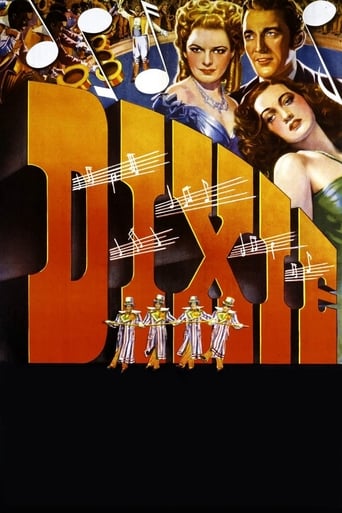


Dixie
A young songwriter leaves his Kentucky home to try to make it in New Orleans. Eventually he winds up in New York, where he sells his songs to a music publisher, but refuses to sell his most treasured composition: "Dixie." The film is based on the life of Daniel Decatur Emmett, who wrote the classic song "Dixie."
-
- Cast:
- Bing Crosby , Dorothy Lamour , Marjorie Reynolds , Billy De Wolfe , Lynne Overman , Eddie Foy Jr. , Raymond Walburn


Similar titles
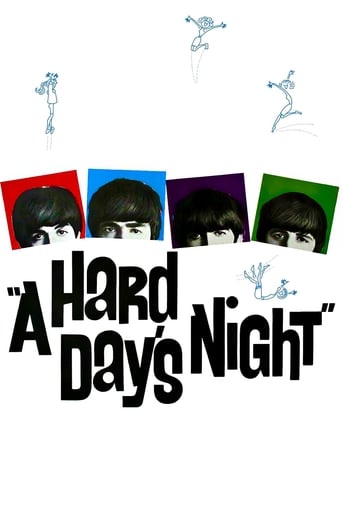
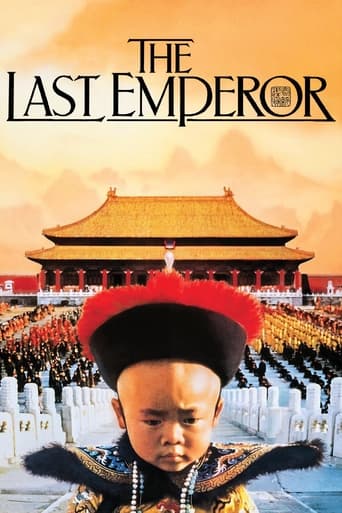
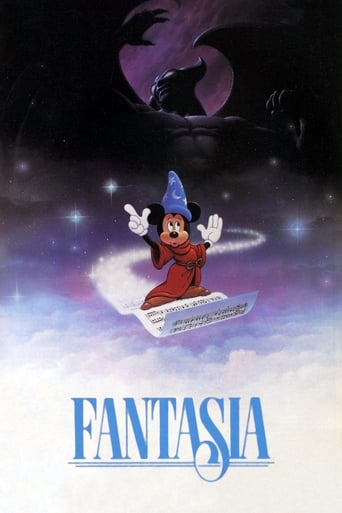

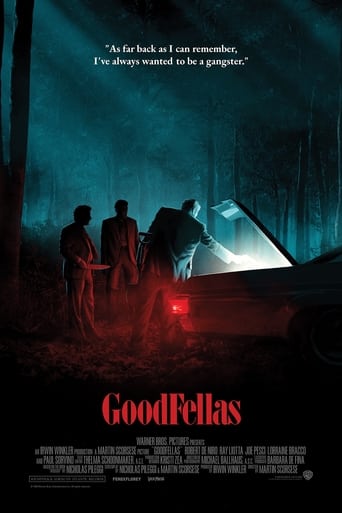

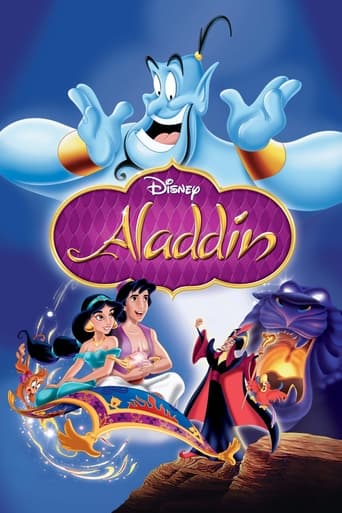



Reviews
Wonderful character development!
Best movie ever!
It's fun, it's light, [but] it has a hard time when its tries to get heavy.
The film creates a perfect balance between action and depth of basic needs, in the midst of an infertile atmosphere.
My title is partially derived from one of the TV episodes of "Julia": a parody of Bing Crosby's hit song from "Holiday Inn", released the year before this film.....It is indeed ironic that "Dixie", as well as most of the other songs that have come to be associated with the antebellum South, were composed by two staunch Yankees: Dan Emmett and Stephan Foster, and mostly for Yankee minstrel shows. Unlike the story in this film, I could find no info that Emmett ever traveled into the South, and Foster made only one trip into the South, by steamboat to New Orleans, rather reminiscent of the scene early in this film when Crosby and a chorus of African Americans sing "Swing Low Sweet Chariot". This scene also reminds us of some of the scenes in Jerome Kerns' "Showboat". Emmett is also credited with being the inspiration behind the first full-fledged blackface minstrel show, in 1843. As in this film, this consisted of 4 men. However, in the film , the silly excuse for using blackface is to cover up their blackeyes from a brawl. Blackface routines had been around in the US since early colonial days, and in medieval Europe. Emmett was primarily a singer and instrument player, and had used blackface in his routines in circuses before this time. In the long interval between '43 and '58, he did not perform in minstrel shows, serving as a musician in various other capacities. Emmett composed "Dixie" in 1859, while a member of a NYC minstrel group. Initially a hit in the North, it was modified into a band piece and war song for the South, with many different lyrics. As in the finale, a performance in New Olreans did spark its popularity in the South. Unlike in the film, where he refuses to sell the copyright for $1., he sold it for $500. to a NYC firm. The fictitious bit in the film where Emmett is given $500.by his prospective father-in-law is perhaps derived from this bit of history.Although this is supposed to be a biographical treatment of Emmett, nearly all the details are totally fictitious, and nearly all the other songs were either new creations for this film, or 19th century songs composed by others! He had two wives, but they certainly weren't southern belles, as portrayed, one being from NYC and the other from Chicago, and they weren't competitors. The plot construction is a switcheroo romantic quadrangle: a very common plot formula in musicals of this era. If we substitute Fred Astaire for Billy De Wolfe and Vrginia Dale for Dorothy Lamour, we have essentially the same romantic melodrama as in "Holiday Inn" of the previous year. In both films, Crosby and Marjorie Reynolds end up a romantic couple in the finale. Dorothy is portrayed as a shameless hussy of a southern belle, whereas Marjorie is portrayed as true to Emmett, but offering to step aside for Dorothy when she discovers that Emmett planned to ditch her for Dorothy until he discovered that she had become partially paralyzed from polio, She surmised that he married her only out of pity. Incidentally,paralytic polio was a rather common and much feared disease when this film was made, exemplified by President Roosevelt. But, back in mid-19th century, it was a minor disease, and mostly of infants and young children, very rarely adults.This was the film debut for comedic character actor Billy De Wolfe, and he almost steals the show in the middle half, before mostly disappearing in the last portion.He essentially takes the place of Bob Hope, Fred Astaire, Martha Raye or Betty Hutton in Crosby's films of this era. He would help to enliven "Blue Skies": the second and less entertaining pairing of Crosby and Astaire.The film fails to convey the fact that his character's name: Mr. Bones, was a stock character in minstrels, originating from the use of 2 bones as a crude castanet. Mr. Bones was also one of the main characters in the extensive minstrel show in "Babes on Broadway".The 3 building fires served as a running gag, each supposedly started by Bing forgetting his lit pipe. Must have had some gasoline-soaked tobacco in that pipe! The first 2 fires served to end one phase of the film, while the last serves as an excuse to speed the tempo of "Dixie", and to destroy Marjorie's now unwanted letter of proposed divorce.This film is notable for the large amount of blackface entertainment. I have no problem with that. To me, it's no different from other forms of stage, film and circus clowning around, including all those 'white face' circus clowns. Historically, AAs often participated in such minstrel shows post Civil War. The NAACP is far too uptight about any public entertainment that portrays AAs in the stock negative characterizations of minstrel shows, early films, and the 'Amos and Andy' TV show, which was one of my favorite shows as a kid. Unfortunately, TV executives overreacted to criticism of the characterizations in this show and cancelled all shows dominated by AAs, including Nat Cole's show.Finally, in the late '60s, "Julia" was tried. It was the first sitcom to present AAs as legitimate middle class Americans, but was criticized for presenting an atypical AA characterization. The characters were said to be essentially 'whites with black faces' and Ms. Carroll was a light-skinned AA, thus a compromise AA.See this film on You Tube, in 9 segments. Rating: 2 for historical accuracy, 7 for entertainment value.
Dixie is a highly fictionalized biography of Daniel Decatur Emmett who was born in Mount Vernon, Ohio and was twice married: to Catherine Rives, who died in 1875 and then to Mary Louise Bird, a widow with two daughters.Emmett performed his first song Old Dan Tucker at the age of fifteen. He was one of four men in the "Original Virginia Minstrels," with Frank Brower. Billy Whitlock, and Dick Pelham. Emmett later performed with Bryant's Minstrels in New York and then with Leavitt's Gigantean Minstrels. Emmett wrote the song Dixie in the spring of 1859, while with Bryant's Minstrels in New York. At the beginning of the Civil War both armies marched to the tune of Dixie but by 1861 Dixie had become a Southern tune.The movie is essentially a series of songs and 'black-face' acts. The latter, although generally considered humorous in 1943, will probably offend many viewers today.
In the movie Dixie (1943), it was apparent that at this civil war time entertainment there were different styles of dance emerging. During this time it became a popular diversion to spend evenings at a minstrel theater. Straying away from the traditional opera or ballet, minstrels offered a new sense of entertainment which promoted the class system. Fortunately our society today is accepting African Americans and prejudices are less prevalent. Subsequent to professional minstrelsy's decline in th 20th century, its appeal continued in the south. Though Minstrels proposed stereotypes, some good did result from this type of entertainment. These shows presented black performers the opportunity to build a foundation which later helped many of them to emerge as successful entertainers.Minstrel shows exposed a wide selection of audiences to this unique type of entertainment. With its combination of eccentric dancing and diverse music, people enjoyed the allure of the entertainment. Closely similar to tap dancing, it boasted innovative and bizarre movements' pairs wit flamboyant eye-catching costumes.This type of amusement contributed to later types of dancing and entertainment. As a big benchmark in the industry, without minstrels played a role in what dancing has evolved into presently. Without minstrels, who knows if the great such as Dizzy Gillespie, W.C Handy, and Bert Williams, would have been as successful as they were.
Dixie is about a man, Dan Emmett, who goes to New Orleans, Louisiana to try and make it big. He goes to New York to try and sell his songs, but refuses to sell one very important one, "Dixie." The movie stars Bing Crosby as Dan Emmett, Dorothy Lamour as Millie Cook, Billy De Wolfe as Mr. Bones, and Marjorie Reynolds, as Jean Manson. There are many other characters in the movie, but these were the key ones. Dixie was directed by A. Edward Sutherland. The movie was released in 1943, by Paramount Pictures. Dixie has many settings. The movie starts off in Kentucky, where Dan Emmett is telling the love of his life that he is going off to New Orleans to try and become famous so that him and her can finally get married and have a life of their own. On his way to New Orleans, Dan meets a man named Mr. Bones. Mr. Bones is a con man. He conned Dan out of $500. They become partners and come up with an idea of a show. The type of show that they created was called a Minstrel Show. Minstrel Shows were when white men performed in "blackface." Minstrel shows were made to be funny. The men would completely paint their faces except around their eyes and mouth to make them look like clowns. In this time black men were not allowed to perform on stage, especially with white men. Dan meets Millie Cook and falls in love with her, and promises to marry her. He then realizes that he must go back home to Kentucky and tell Jean his already fiancée that they weren't going to get married. When he arrives there he sees that Jean is in a wheelchair and is not able to walk by the paralyzing sickness. He then promises Jean that no matter what they would get married. He writes to Millie telling her this. Jean and Dan go to New York where they try and make a life together. Dan tries and sells his songs, but has a hard time. He ends up selling 10 of his songs for $100. The only one he didn't want to give up was the song that he wrote "Dixie." Mr. Cook, Millie's father, comes to New York and asks Dan to come back to New Orleans with his new bride. This is when Jean finds out that Dan and Millie were engaged. They go back to New Orleans where they start another show of the same genre, minstrelsy. This is when Dan is finally able to use the song that he had been trying to put to the show the whole time, but it just didn't sound right. The movie ends with the audience singing along with the cast and the show was a hit. Between the years 1840 1920, Minstrel shows were put on all over the United States, but mostly in the South. "The American musical has one shameful chapter in its history minstrel shows. The most popular musical stage shows of the early and mid 19th Century, minstrelsy embodied racial hatred. Both white and black performers donned blackface, and audiences of all colors loved it. Minstrel shows developed in the 1840's, peaked after the Civil War and remained popular into the early 1900s. Minstrelsy was a product of its time, the only entertainment form born out of blind bigotry. In these shows, white men blackened their faces with burnt cork to lampoon Negroes, performing songs and skits that sentimentalized the nightmare of slave life on Southern plantations. Blacks were shown as naive buffoons who sang and danced the days away, gobbling "chitlins," stealing the occasional watermelon, and expressing their inexplicable love for "ol' massuh." In the early 1840s, a group called the Tyrolese Minstrel Family toured the United States with a program of traditional mittel-European folk songs. Four unemployed white actors decided to stage an African-American style spoof of this group's concerts. Calling themselves Dan Emmett's Virginia Minstrels, their blackface revue premiered at New York's Bowery Amphitheatre in February 1843. Emmett, Frank Bower, Frank Pelham and Billy Whitlock became the first troupe to offer a full evening of blackface variety entertainment. With their chairs in a simple semi-circle, the quartet offered a fresh combination of songs, dances and comic banter, creating cartoonish Negro caricatures. Most historians mark this production as the beginning of minstrelsy. Companies continued to perform in both North and South throughout the Civil War, with the minstrel tune "Dixie" becoming an unofficial anthem for the Confederacy. After the war, minstrelsy remained popular, and many skits took a sentimental view of the lost world of plantation slavery. Although African Americans were forbidden by law to perform on stage with whites in many states, some companies secretly included blacks. As laws changed, several all-black minstrel companies toured America and Great Britain. Black performers still had to wear blackface makeup in order to look "dark enough," performing material that demeaned their own race. Despite such drawbacks, minstrelsy provided African American performers with their first professional stage outlet" (Kenrick).The movie started out a little slow, but as the movie went on I got more and more interested in the story line and the plot. It was interesting to learn about the Minstrel shows and how they were performed, and why they were performed. I think that the movie was a little controversial, because of the fact that it poked fun and put down blacks. I honestly don't understand how people could have hated a group of people. It was degrading to blacks.
